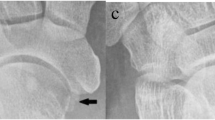Abstract.
The aim of this study was to investigate the presence of fibrocartilage within the distal posterior tibial tendon (PTT) before its division correlating with size and signal variation on MR images through a radio-anatomic and pathologic study. Eight fresh cadaveric feet underwent MR imaging were cut into 4-mm slices in the axial plane. The PTT specimens were harvested at the tendon distal portion before its division and sent to pathology. Thirty-three asymptomatic subjects underwent axial double-echo turbo-spin-echo MR imaging. Proximal and distal PTT signal and diameter were evaluated. In cadavers, every PTT flared distally. Intratendinous fibrocartilage and ossified sesamoid were found in, respectively, 87.5 and 12.5% of the cases. Distal PTT flaring was demonstrated in 100% of the asymptomatic subjects (mean diameter 8 mm). An intratendinous high signal intensity on proton-density-weighted images and sesamoid bone were evidenced in, respectively, 36 and 33% of the cases. Proximally, PTT presented a 4-mm mean diameter and was hypointense in 100% of the cases. Only one accessory navicular bone was detected. Laterally off-centered increased intratendinous signal intensity as well as PTT distal widening with otherwise normal MR imaging features are related to an intratendinous fibrocartilage.





Similar content being viewed by others
References
Johnson KA (1982) Tibialis posterior tendon rupture. Clin Orthop 177:140–147
Conti S, Michelson J, Jahss MH (1992) Clinical significance of magnetic resonance imaging in preoperative planning for reconstruction of posterior tendon ruptures. Foot and Ankle 13:208–214
Funk AF, Cass JR, Johnson KA (1986) Acquired adult flat foot secondary to posterior tibial tendon pathology. J Bone Joint Surg 68:95–102
Rosenberg ZS, Jahss MH et al. (1988) Rupture of the posterior tibial tendon: CT and MR imaging with surgical correlation. Radiology 169:229–235
Schweitzer ME, Caccese R et al. (1993) Posterior tibial tendon tears: utility of secondary signs for MR imaging diagnosis. Radiology 188:655–659
Schweitzer ME, Karasick D (2000) MR imaging of disorders of the posterior tibialis tendon. AJR 175:627–635
Khoury NJ, El-Khoury, Saltzman CL, Brandser EA (1996) MR imaging of posterior tibial tendon dysfunction. AJR 167:675–682
Benjamin M, Qin S, Ralphs JR (1995) Fibrocartilage associated with human tendons and their pulleys. J Anat 187:625–633
Sarin VK, Erickson GM, Giori NJ et al. (1999) Coincident development of sesamoid bones and clues to their evolution. Anat Rec 257:174–180
Gray H (1901) Osteology. The skeleton. Sesamoid bones. In: Pick TP, Howden R (eds) The unabridged running press edition of the American classic anatomy, descriptive and surgical. Running Press, Philadelphia, London, pp 214–215
Testud L, Latarjet A (1948) Traité d’anatomie humaine (T1) G. Doin et Cie, Paris
Boyer (1815) Traité complet d’anatomie ou description de toutes les parties du corps humain (T 2), 4ème ed. Migneret, Paris, pp 398–399
Sappey PHC (1888) Traité d’anatomie descriptive (T 2). A. Delahaye, Elecrosnier, Paris
Rufai A, Ralphs JR, Benjamin M (1995) Structure and histopathology of the insertional region of the human achilles tendon. J Orthop Res 13:585–593
Le Double AF (1897) In: Frères S (ed) Traité des variations du système musculaire de l’homme et leur signification au point de vue de l’anthropologie zoologique, vol 2. Paris, pp 323–325
Kruse RW (1995) Accessory bones of the foot: clinical significance. Mil Med 160:464–467
Bareither DJ, Muehleman CM, Feldman NJ (1995) Os tibiale externum or sesamoid in the tendon of tibialis posterior. J Foot Ankle Surg 34:429–434
Mosier SM, Pomeroy G, Manoli A (1999) Pathoanatomy and etiology of posterior tibial tendon dysfunction. Clin Orthop 365:12–22
Kaplan PA, Nelson NL, Garvin KL, Brown DE (1991) MR of the knee: the significance of high signal in the meniscus that does not clearly extend to the surface. AJR 156:333–336
Mink J, Levy T, Crues J (1988) Tears of the anterior cruciate ligament and menisci of the knee: MR imaging evaluation. Radiology 167:769–774
Stoller DW, Martin C, Crues JV, Kaplan PA, Mink JH (1987) Meniscal tears: pathologic correlation with MR imaging. Radiology 163:731–735
Kojima KY, Demlow TA, Quinn SF (1996) Coronal fat suppression fast spin-echo images of the knee: evaluation of 202 patients with arthroscopic correlation. Magn Reson Imaging 14:1017–1022
Fellner C, Geissler A, Held P, Strotzer M, Tribel W, Fellner F (1995) Signal, contrast and resolution in optimized PD and T2-weighted images of the knee. J Comput Assist Tomogr 19:96–105
Pech P, Haughton VM (1985) Lumbar inter-vertebral disk: correlative MR and anatomic study. Radiology 156:699–701
Schiebler ML, Grenier N, Fallon M, Camerino V, Zlatkin M, Kressel HY (1991) Normal and degenerated intervertebral disk: in vivo and in vitro MR imaging with histopathologic correlation. AJR 157:93–97
Erickson SJ, Cox IH, Hyde JS, Carrera GF, Strandt JA, Eastkowski LD (1991) Effect of tendon orientation on MR imaging signal intensity: a manifestation of the magic angle phenomenon. Radiology 181:389–392
Peh WCG, Chan JHM, Shek TWH, Wong JWK (1999) The effect of using shorter echo time in MR imaging of the knee menisci: a study using a porcine model. AJR 172:485–488
Smith CF (1999) Anatomy, function, and pathophysiology of the posterior tibial tendon. Clin Podiatr Med Surg 16:399–406
Premkumar A, Perry MB, Dwyer AJ, Gerber LH, Johnson D, Venzon D, Shawker TH (2002) Sonography and MR imaging of the posterior tibial tendinopathy. AJR 178:223–232
Author information
Authors and Affiliations
Corresponding author
Rights and permissions
About this article
Cite this article
Delfaut, E.M., Demondion, X., Bieganski, A. et al. The fibrocartilaginous sesamoid: a cause of size and signal variation in the normal distal posterior tibial tendon. Eur Radiol 13, 2642–2649 (2003). https://doi.org/10.1007/s00330-003-2067-5
Received:
Revised:
Accepted:
Published:
Issue Date:
DOI: https://doi.org/10.1007/s00330-003-2067-5




